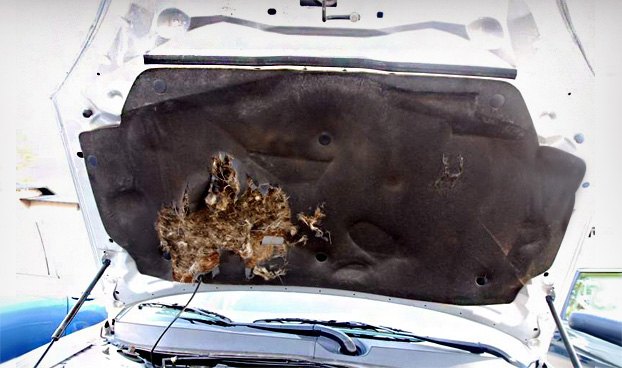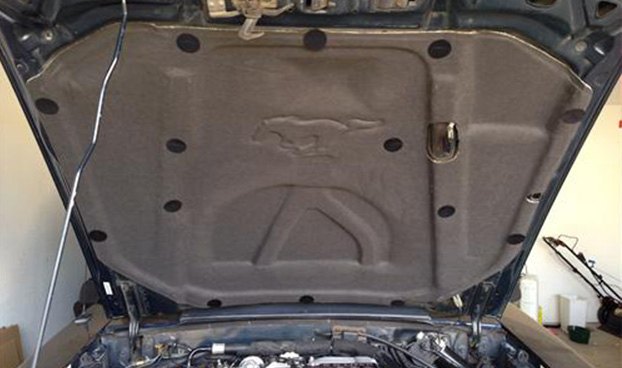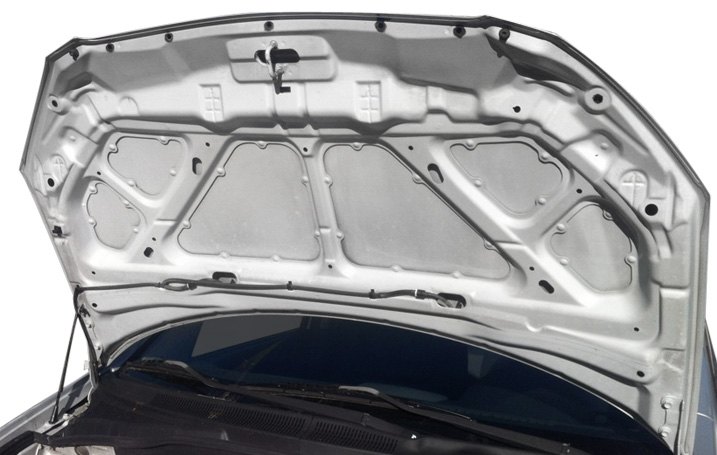Hood insulation pads provide numerous benefits - some of which you may not even realize. For starters, air pockets within the liner material effectively muffle engine noise. Your motor may already run quietly - but if it doesn't, it may generate the type of loudness that's tiresome to the ear. Hood pads will quiet things down a bit.
Hood Pads Retain Engine Heat – And That’s Good
Insulated pockets that hood pads contain also trap and absorb engine heat. During cold startups, retaining that heat at idle results in faster warm-up times. Engine oil transforms from cold, thick syrup to flowing fluid without delay - providing faster lubrication to engine parts that need it. Retaining heat also helps emissions systems reach peak efficiency much sooner - extending the life of expensive exhaust system components such as catalytic converters and oxygen sensors. And last, but not least, you'll feel warm air coming out of your cabin vents sooner.
Hood Pads Keep Hood Paint And Decals Intact

Because the majority of the heat absorbed by the hood insulation pad doesn't reach the surface of your hood panel, the paint on top will not suffer. Warmth that does radiate upward to the metal is evenly disbursed, not concentrated in spots as it would be without protection.
This is something to consider if you've got a classic with decal stripes or logos, because excessive temperatures tend to make them brittle and peel. Remember, it's not when you're vehicle is moving that heat builds up, it's when you park it afterward. Heat rises, and the paint on a hood can get pretty hot without air flowing and no insulation pad in place.
Hood Pads Are Designed To Smother An Engine Fire

You may not realize that newer hood pads are designed in such a way as to prevent the spread of underhood engine fires. Clips made of plastic or metallic compounds are designed to melt quickly, causing the pad itself to drop on top of the engine. Fire retardant construction can serve to smother a small engine fire before it becomes a big one.
Hood Pads Degrade Over Time – Regardless Of How You Drive
Hood pads degrade after years and miles of exposure to engine heat, humidity changes, wintry conditions, and even animals that burrow their way in looking for secure places to stash acorns. And even if you have a garage-kept classic that doesn't get driven much, older padding materials tend to dry up and crumble over time - no matter what.
Tiny pockets designed for insulation we mentioned before also become naturally saturated with dirt, grime, motor oil, and other fluids if leaks exist. This cuts down on a pad's effectiveness, and creates a filthy mess. Chances are, if you haven't taken a close look at the condition of your hood pad lately, it's in worse shape than you thought.


So if you've been dealing with an old pad that's falling down and coming apart in pieces, replacing it is as easy as pulling the old one off and clipping a new one in place. Whether you are completing a full-on restoration, or just performing a visual "refresh", a replacement hood pad looks crisp and adds a finishing touch.

It's also possible your older vehicle never had a hood pad from day one. Sometimes, lower-trim versions of cars and trucks were built without hood pads to keep costs low, so they were never installed on the assembly line. A previous owner may have removed a worn pad and never got around to purchasing another one. Or, if the hood was replaced or repaired due to accident damage, the pad replacement may have been overlooked.
Hood Pads We Offer
The Goodmark Hood Insulation Kit specializes in recreating original thicknesses and dimensions when it comes to hood pads. There, you'll find coverage for popular GM muscle and mid-size cars from the 1960s and 1970s. Depending on year, make, and model, your pad may or may not come with clips, and may require minor trimming to fit. The Genuine Hood Insulation Pad offers replacement pads for BMW and Mercedes vehicles from the 1960s through today, along with select Porsche, Volkswagen, and Mini models.


The Omix-Ada Hood Insulation Liner specializes in select Jeeps back to the 1980s, and JL’s Hood Insulation Pad offers a good selection for late model Volkswagens. And if you're looking for a faithful re-creation of original hood pad looks, OPGI’s Hood Insulation kit covers popular General Motors models from the 1950s through 1993, and even offers a choice of colors for some applications. Depending on vehicle application, you may be presented with a choice of "molded" (shaped with indentations or cut-outs where larger engine parts sit) or "flat" (non-indented).

If you've got a MoPar muscle car from 1966 through 1974, you'll find a good selection for those as well as select 1958-81 GM models with Soffseal's Hood Insulation kit. For owners of turbocharged Minis, the M7 Speed High Performance Heat Shield (choose N14B for 2007-2010 models or N18B for 2011-on models) is designed to fit not on the underside of the hood, but over the factory turbo using pre-existing mounting points. With ceramic thermal blanket material, these insulation pieces minimize the amount of heat transferred from high-temperature turbochargers that tend to damage paint or factory hood scoops.

Once you've got a new hood insulation pad on your vehicle, you'll be able to open your hood with pride - and you will have protected it in many ways. We're confident you'll be happy after purchasing any of the products we've discussed here, whether it's solely to replace a torn and worn item, or as part of a bumper-to-bumper restoration. Happy hood insulation pad hunting!

